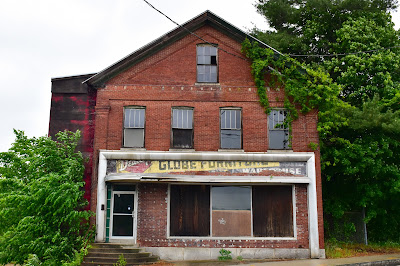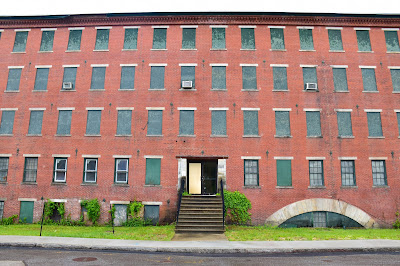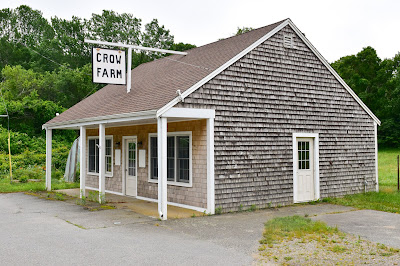From Dave Brigham:
I recently swung through the former mill town of Southbridge, Mass., yet another place I picked off a map that's between my home in the Bay State and my mother's place in Connecticut. In this first of two parts I will cover a lot of ground: cool roadside Americana stuff, ghost signs, old mills, former fire stations, a historic train station, murals and so much more. In the second installment about this small city (Southbridge has a city form of government, but retains "the Town of" in its name), I will rave on about tons of neat old buildings, including former optical industry operations and churches.
Southbridge is located just over the border from Woodstock, Conn., and at the 2010 census had a population of 16,719. The town has a "long history of manufacturing optical products, earning it the unofficial title 'Eye of the Commonwealth,' in reference to the Commonwealth of Massachusetts," per the official Southbridge web site. " Under the Wells family, the American Optical Company became the world's largest manufacturer of ophthalmic products, and at its height employed more than 6,000 people around the world. The industrial revolution brought rapid growth to Southbridge, and with growth came varied neighborhoods and a historical downtown with Victorian architecture and large, shady streets. Industry also brought successive waves of immigration as people from many nationalities moved here to work in the mills. Neighborhoods developed near industry, while outlying areas remained largely agricultural."
The gateway to Southbridge as one approaches along Main Street from the west is Big Bunny Market.

Founded in the early 1950s, the grocery store has been family-owned and operated all along, according to its web site. I learned about this local landmark by doing some research ahead of time. I was thrilled to see the bunny sporting a Bruins sweater!
There are several stores and eateries in the Big Bunny Plaza. Jim's Liquors is your standard package store, but the signage on the rear of the building is one-of-a-kind.

That Schlitz sign may be worth some money. And the BOOZE sign is just fantastic. I'm guessing there was more to it at some point, and that this is the ghost of it. In my dreams, the original sign lit up and flashed like a beacon in the night.
Steps away is Burrito Hut.

I'm not sure how long this place has been in business. Prior outfits included the Clam Shack and Grumpy's Diner, according to the Internet. I found a photo on Flickr of Grumpy's. One of the comments under the photo indicates that, while the building looks like an old diner, it isn't. "[T]hey copied enough Worcester Lunch Car detailing that I thought maybe it was real, much remodeled," that person wrote.
I'm guessing there were actual diners in Southbridge at some point.
Across Main Street from the Big Bunny Plaza is the Pilsudski Polish American Club.

The club is named for Jozef Pilsudski, who "was a Polish statesman who served as the Chief of State (1918–1922) and First Marshal of Poland (from 1920), according to Wikipedia. "He was considered the de facto leader (1926–35) of the Second Polish Republic as the Minister of Military Affairs. After World War I, he held great power in Polish politics and was a distinguished figure on the international scene."
A short distance away, on Pleasant Street, is The Lounge, which looks simultanously unwelcoming and somewhat cheerful. The martini glass on the sign is a nice touch, as are the Christmas wreaths nailed between the second-story windows (even though I shot these photos in May).

The fact that you can't see into this place, however, might make one a little leary of just walking in the door. Anyway, it has the coldest beer in town, so it must be good.
As I mentioned above, I did some research before hitting Southbridge. When my time is limited, sleuthing around on Google Maps and Flickr ahead of time is absolutely critical. Two places in close proximity popped off Google Maps. I may have drooled when I saw them.
The first was the Alden-Delehanty Block, on Main Street.

Located in what is known as the Globe Village section of Southbridge, this Victorian beauty dates to 1888, according to Wikipedia. "The block was built...for William E. Alden, who operated a dry goods store on the first floor. The building originally housed shops on the ground floor, offices on the second, and a meeting hall space on the third floor. The latter was used for a time by the Ancient Order of Hibernians....The building was acquired in 1899 by John Delehanty, who owned a furniture store that had expanded to occupy the entire building."
I love that the current owner(s) kept the old painted signage on the building.
The ground-floor space has been occupied since 2008 by seafood restaurant Fins & Tales.


The upper floor's tenants include (and may be limited to) the local Lions Club, the entrance to which is under the green awning in the photo below.

On the opposite side of Main Street is the other building that caught my eye on Google Maps, the former Globe Furniture building, below.

I haven't found out anything about the furniture company. My favorite and most trusted source, MACRIS, tells me this building dates to 1850 and is known historically as the Hamilton Woolen Company Counting House. I'll get to the woolen company shortly.
Directly behind the old counting house is Peterson Oil.

I'm guessing at least one of these buildings was once part of the woolen company, too.
Steps away on Main Street is Metal Craft Machining.


I haven't found any information on the history of this building; it could be part of the old woolen mill.
Also in this area is the former Globe Village Fire House.

The building dates to 1894, and is currently used by the city for other purposes than firefighting.
OK, let's talk about the Hamilton Woolen Company and its mill complex.


Built in 1836, the mill was the first of four that Hamilton Woolen built in Southbridge prior to the Civil War, according to MACRIS. An 1850 fire destroyed the mill's interior; it was rebuilt with a flat roof and no clerestory, as the original one had. It was reportedly the largest mill of its type when it was erected. Until 1886, the company made high-grade woolen or worsted fabric known as delaines, which were used for women’s dress material. After that, Hamilton manuactured worsteds for ladies wear. I don't know what any of that means....

Among the companies currently in the old mill space are Abacus Distributing, A&M Tool & Design and Green Meadows, a cannabis dispensary.
Across Mill Street from the former wool plant is a Fraternal Order of Eagles (FOE) club.

Regular readers of the blog will recall that I have a fondness for social/fraternal clubs and organizations. This interest is unusual, as I am not a member of any such organization, nor have I set foot in such clubs other than for weddings. Anyway, I first realized this odd passion during my college years in Keene, NH, as I outlined in a post from October 2019.
About a mile southeast of the old woolen mill is the former Central Mill, which manufactured cotton jeans and flannels, according to MACRIS.


Now home to companies including Sadie Green's jewelry, Yards of Hope lawncare service and Just the Details auto detailing, the old mill also houses an office of the Massachusetts Office of Transitional Assistance and the Department of Developmental Services.
Across North Street from the rear of the old mill is the Italian-American Club.

Steps away is a remnant of an abandoned railroad track.

Those tracks once led to Southbridge Station, which was part of the NY, NH & Hartford Railroad).

Now home to a branch of the Massachusetts Registry of Motor Vehicles, the station dates to 1910. "[B]uilt in a Spanish Colonial style, with stucco walls and tile roof...[t]his depot...served as a passenger station until 1930," per Wikipedia. "Its style, which is uncommon in any sort of building in central Massachusetts, was somewhat typical for railroad-related infrastructure during the early 20th century."
Behind the station is an old caboose.

Walk from the caboose just a few steps and you'll be at Los Hermanos Market.

I dig that sign, but not as much as I love the mural on the side of the market.

Across Larochelle Way from the RMV is a former auto parts store.

On the rear of the old auto parts business are some really cool murals.



Across the parking lot from those murals there is a gigantic one on the side of Fedele's Coffee Shop along Central Street.

I haven't found any information about these great public works of art. In addition to these cool paintings, I found some cool stores, restaurants, houses of worship, statues and more on my tour.
Nearby is the former Silver Chief Trading Post.

I love the color scheme of the signage for Delicia's Restaurant & Bakery, on the opposite side of Central Street.

Two doors down is LJ's Sportscards, which, despite its name, is "primarily a magic the gathering [sic] store" that also has "computers action figures, funko pops," and Pokemon and Yugio, per its Facebook page.

Over on Hamilton Street, which parallels Central, I spied a storefront church.

Iglesia Pentecostal: Road to Jesus Christ is located in what seems to be an old, but solid, building.
Below is an interesting mish-mash of businesses: Finally Lisa's Hair Salon, the Flea Mart, Starlite (a contemporary art gallery, performance space and craft cocktail bar) and Crown Fried Chicken.


(The Starlite sign.)
Steps away from these businesses, in a small triangle in the middle of Hamilton Street, is a monument to the Southbridge citizens "who served in the war with Spain, the Phillippine Insurrection and the China relief expedition. Army in Cuba and Porto Rico" from 1898-1902.


Further north on Central Street, past the former Central Mill, is another Iglesia Pentecostal.

This one's subtitle is Mount Zion Cornerstone.
Also near the old Central Mill complex is St. George Greek Orthodox Church, which is quite beautiful.

I'm going to wrap up on Mechanic Street, which is close to where I will start the second part of my Southbridge series. From the looks of it, Renaud's TV & Appliances is out of business.

I dig the old sign on the side of the building.

That's it for Part One. In the second installment in this short series I will cover some of the significant former optical businesses in town, as well as additional downtown retail buildings and more.



















